These blotters from the Dale Hastin collection all advertise C&NW trains that reach California via the Union Pacific from Omaha. PDFs of the blotters are about 400 to 600 KB in size.
The tiny numbers in the lower left corner of this blotter suggest that it was published in 1910 and that 15,000 copies were made. The date is plausible as the Overland Limited began operation in the late 1890s and the Los Angeles Limited in 1905.
Ten thousand copies of this blotter aimed at San Francisco travelers were apparently printed in 1930.
Similarly, the code in the lower left corner of this blotter suggests 25,000 copies were printed in 1932. Again, the date makes sense as all the trains listed were operating in that year.
This 1936 blotter, of which 100,000 were apparently printed, advertises free drinking cups for coach passengers on the Challenger. That train was inaugurated as a low-cost alternative all-Pullman trains such as the Los Angeles Limited in 1935.
Another 50,000 copies of a nearly identical blotter were printed in 1937.
The UP/C&NW City streamliners went daily in the late 1940s, so this undated blotter dates from then or a little later.

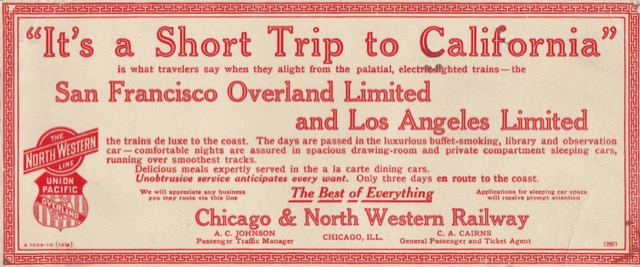
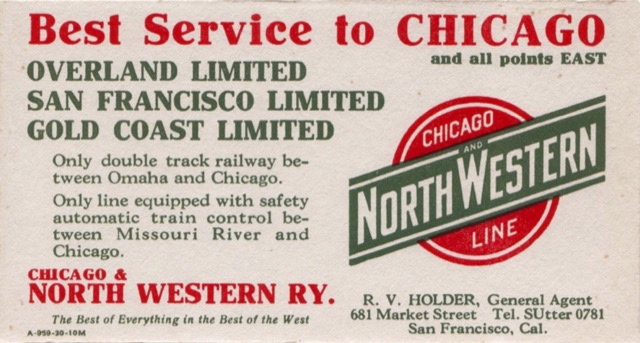
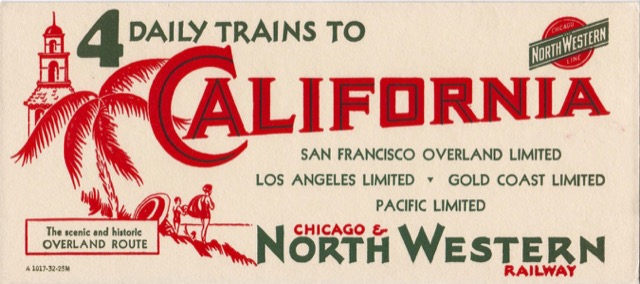
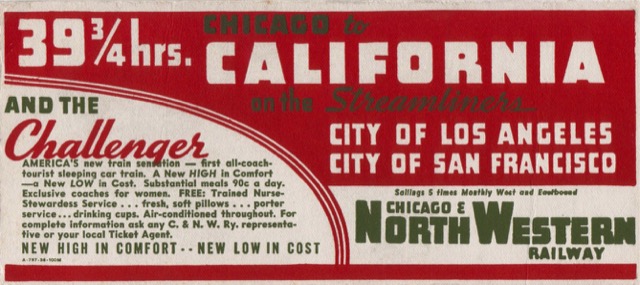
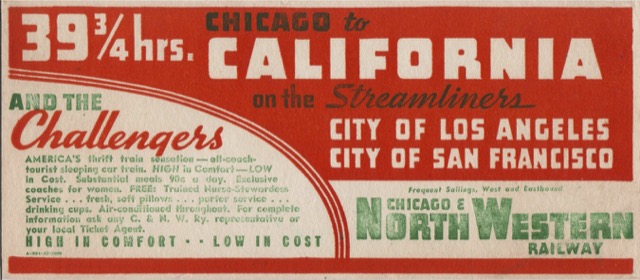
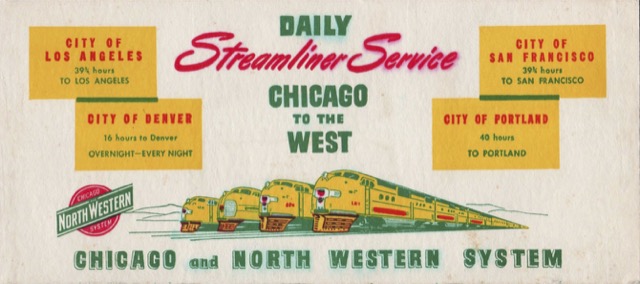
So nice to see the “City” trains when they were still viable means of travel. It wasn’t long before a “City of Everywhere” replaced the really fine name trains on the UP. The excellent level of service and food hung on until about 1960 and then started a dramatic decline. I rode the “City of Los Angeles” in 1959 and had a really enjoyable trip. The food in the diner was still good and relatively cheap. The cars were clean and well maintained. There were still dome cars, and watching the thunderstorms on the Plains was a real treat from the dome at night. My roomette was spotless, with clean and soft bed linens and an attentive porter. I fell asleep easily at about 1:00 am after watching the thunderstorms and I don’t think I ever felt any bad track or car movement. We arrived in Chicago five minutes ahead of schedule.
I made the mistake of taking what was left of the same train to Chicago in 1968. The “City of Los Angeles” and the “City of San Francisco” had already been combined into one train as the “City of Everywhere” trend was well underway. The entire train, inside and out, was filthy. No more domes, and the lounge and parlor cars were filled with cigarette smoke due to a defunct ventilation system. I was a smoker back then, and even I couldn’t stand the air in those cars. The A/C worked intermittently in about half the cars and not at all in the other half. This was in July, with temperatures well above 100 for most of the trip. The food in the diner tasted like it was prepared before the train left and then reheated. Breakfast was still OK, since they had to cook most of the entrees in the diner, but lunch and dinner were both terrible and expensive. I subsisted mostly on hot dogs and PB&J sandwiches from the lounge car, since they tasted better than the food in the diner, and the lounge was one car where the A/C worked occasionally. The A/C in my sleeper mostly worked, thank goodness, but the roomette was as filthy as the rest of the train, especially the toilet. After the porter made up my bed the first night, I returned to the room to find the bottom sheet was not only patched and torn where the patching hadn’t been done yet, but it also had several spots of what appeared to be dried blood. It took a half hour to get the porter’s attention and get replacements that were just as torn up, but at least I didn’t see any blood.
The UP E-9’s were on their last legs. We had an 11 car train with five engines. The fireman said they had five engines in the hope that three would still be working when we got to Salt Lake. Alas, it was not to be the case with this trip, as an E-9 broke down about every 200 miles. We were down to 2 engines near Lund, Utah, and they were moving the train at a sprightly 30 mph. Then the second to last engine broke down, and that was the end of that train moving. The train got put in a siding and the road foreman got notified to bring out a set of GP-20’s to pull us into Salt Lake. We sat in the middle of nowhere for almost three hours until the rescue engines hove into sight. At the same time, the crew went dead on the law. The crew in the set of 3 GP-20’s was not passenger train qualified, so we had to sit for another two hours until a crew caller’s van with a qualified crew showed up. With only one E unit providing steam to 11 cars (and this was when the A/C was still run by steam), it was about the most miserable five hours I’ve ever spent on a train. We finally got into Salt Lake about six hours late, just as it was getting dark.
They fixed us up with another five E-9’s and tacked on a steam generator equipped GP-20, just in case. The new crew tried to make up some time, which was commendable, but the UP track at that time wasn’t meant for 90-100 mph running. Between the bad track, leaning into curves at 70 mph, and what I think were some broken springs on my sleeper, I spent almost as much time awake as asleep. I was literally tossed out of bed several times. If you’ve ever travelled in a roomette, you know you don’t have far to get tossed before you bounce off a wall, which I did regularly that night. Even with all the high speed running, we were still five hours late in Chicago. Some of that wasn’t the UP’s fault, since we had line after line of thunderstorms that caused flooding on the line through Nebraska and many slow orders. Still, if we had made Salt Lake on time, we would have only been about an hour late, which wouldn’t have been bad considering the weather.
Sorry for the long-winded post, but I always considered the UP as “my” railroad growing up, and watching the decline and fall of passenger service was really painful. It was like a snowball rolling downhill, with each year showing a decline in patronage and the railroad making service cuts that assured another decline in patronage the following year. Railroads like the UP once considered passenger service as part of their public relations efforts, and losses were expected, especially from the dining car service. Once the accountants and MBA’s took over and expected each division within the company to show a profit, passenger service was doomed. I would pay a lot of money to travel on that 1959 version of the “City of Los Angeles” today, but that train will never come down the tracks again.
Jim